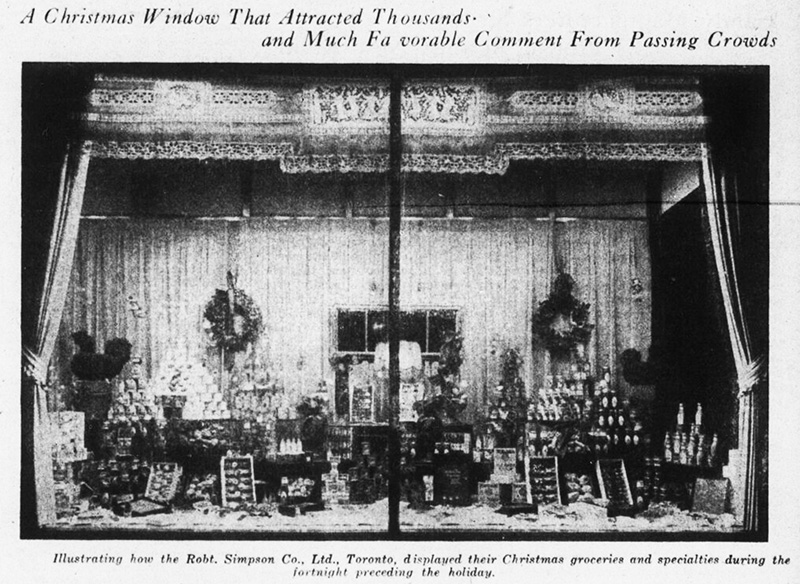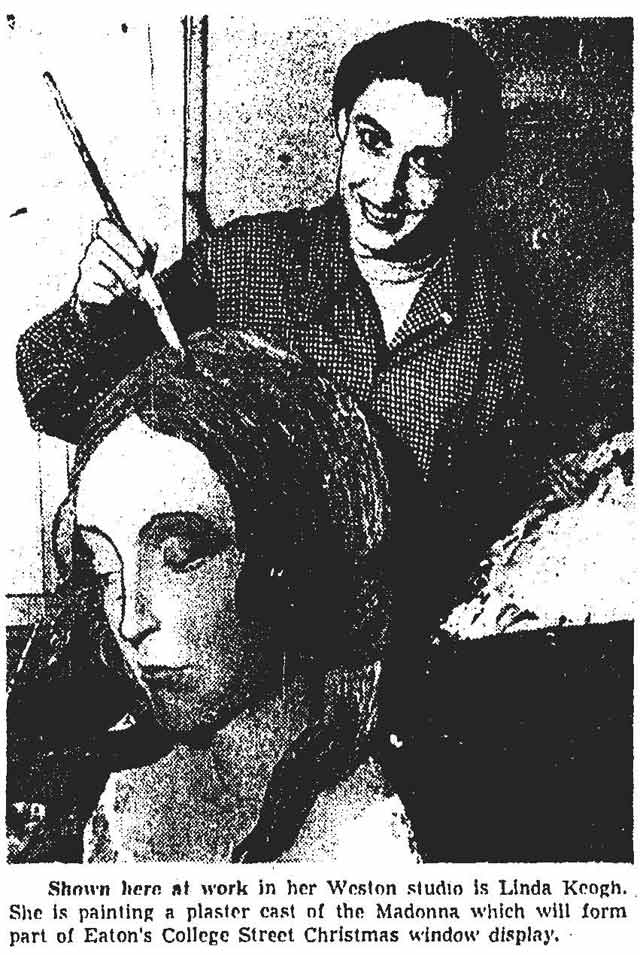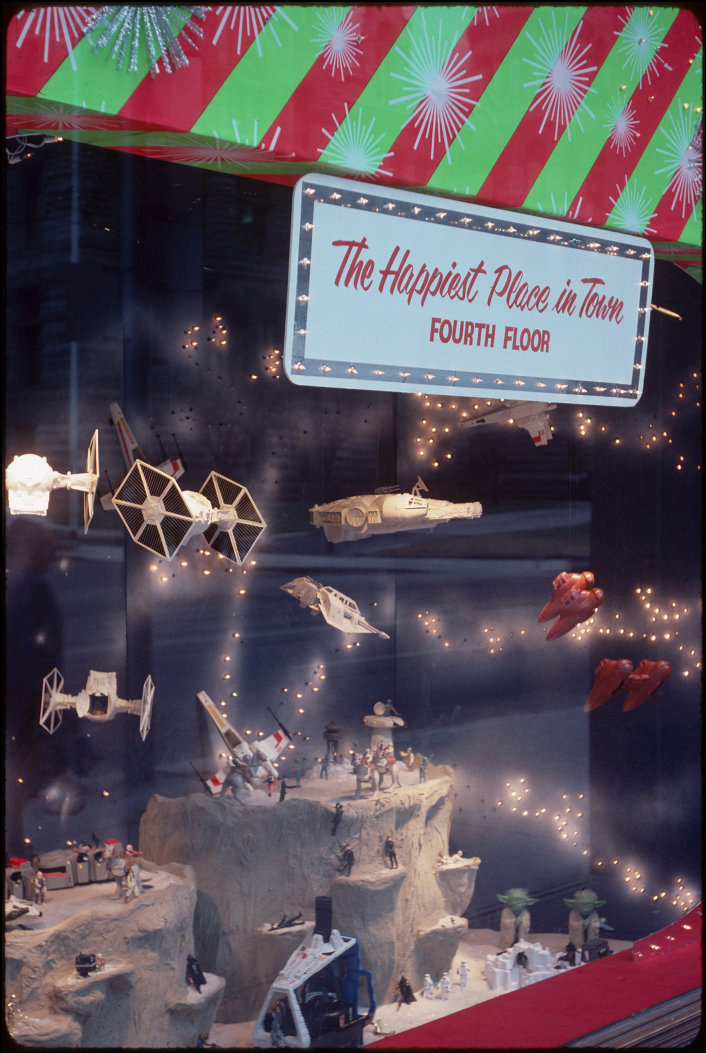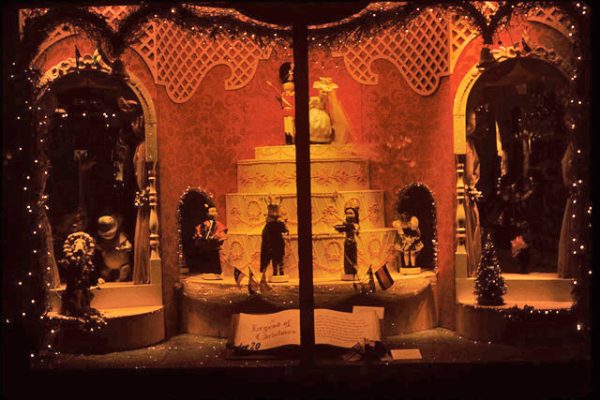Holiday-themed window displays have long been part of our retail landscape. This story, originally published by Torontoist on December 23, 2015, touches upon the greatest Christmas window rivalry in 20th century Toronto, and how modern displays can be used to address social issues.
During the 1926 holiday season the Globe illustrated the annual pilgrimage of shoppers to the Christmas display windows of downtown Toronto’s consumer temples with prose as colourful as holiday lights:
There is a peculiar fascination in Christmas window-shopping, and for the lucky beggar whose purse is at once portly and elastic there is a stimulus in a leisurely stroll along main thoroughfares gazing upon the wonder display flaunted through polished glass plate. On a pre-Christmas afternoon—the purple twilight shattered with shafts of rosy light gleaming from a thousand meteor-lights illuminating the shopping district of the city—men and women, boys and girls loitered in the glare, finding appeal in the magnificence of the Yuletide exhibit.

For decades, Christmas wasn’t complete without viewing the holiday window displays of the rival department store giants at Queen and Yonge: Eaton’s (which also decorated its College Street store) and Simpsons. At their peak during the 1950s and 1960s, crowds jostled for the best view as children and adults stood transfixed by each year’s animated presentation of nativity scenes and Santa’s workshop, and families drove for hours to view the spectacular scenes.
In her book Eatonians, Patricia Phenix described the craft and creativity presented in these via one created for Eaton’s College Street store (now College Park) by Merchandise Display Manager Ted Konkle and his wife Eleanor:
In one illuminated window, movable figures skated figure eights on a Teflon rink; in another, a baby Jesus figure lay in his crèche, surrounded by the figures of three wise men, their velvet costumes designed to Italian Renaissance exactitude. The figures, modelled in Styrofoam, were moved electronically after heated brass rods were inserted in their bases.
The Konkles prepared much of the installation at home, where their clothesline was loaded with papier-mâché figures. “We remember our son sitting in a high chair pounding Styrofoam with something or other,” Ted Konkle recalled. “We were weirdos, let me tell you.”

Weird perhaps, but such efforts worked, pleasing the public and corporate accountants. But something was lost when Eaton’s replaced its downtown stores with its Eaton Centre flagship in 1977—with only three windows along Yonge Street to work with, executives decided there wasn’t room for a holiday display. When the decision was passed off an experiment to gauge public reaction, the Globe and Mail had a simple reaction: “boo.” It’s tempting to treat this as foreshadowing for the retailer’s unpopular decision to drop the Santa Claus Parade in 1982.

Meanwhile, high-end retailers like Creeds on Bloor Street utilized holiday displays inspired by fashionable New York windows, where the icy creepiness of mannequins was used for dark comedic effect. The shock value of designs which skirted the boundaries of good taste made good headline fodder.
For Holt Renfrew, as fashion director Barbara Atkin told the Star in 2001, a good store window is like good sex: it’s all about the fantasy and allure. She noted that any retailer who just filled the window with merchandise didn’t appreciate, in the Star’s words, “the gentle teasing, the fervent anticipation and the climax of landing the sale.” Since the late 1990s, Holt Renfrew has drawn gazes for themes ranging from Alice in Wonderland to Moulin Rouge.
Beyond consumerism, holiday window displays can provide a forum for social issues. For example, in 2015 the scene at Untitled & Co on Queen West resembled a stereotypical nuclear family enjoying Christmas dinner… until the husband slaps the wife. The Ontario Association of Interval & Transition Houses (OAITH) intended to raise awareness of the spike in domestic violence the stresses of the season create.
“We wanted to bring awareness to the public and we wanted women to know and understand that they weren’t alone during this period,” OAITH chair Charlene Catchpole told the Globe and Mail. “That isolation when everybody around you is happy, excited, looking forward to Santa coming and having this big holiday meal, when you can’t afford those things and you’re waiting for that other shoe to drop—we really wanted to let women know that they weren’t alone.”
The traditional department store holiday display continued on at Simpsons’ successor, Hudson’s Bay, though it was suspended in 2023 due to construction of the Ontario Line. Comparing The Bay’s display to Holt Renfrew’s in 2008, the National Post observed that “kids don’t care about couture. They care about Santa Claus and elves.”
Sources: Eatonians by Patricia Phenix (Toronto: McClelland and Stewart, 2002); the December 14, 1926 edition of the Globe; the November 25, 1977, April 5 1980, and December 14, 2015 editions of the Globe and Mail; the November 1, 2008 edition of the National Post; and the December 20, 2001 edition of the Toronto Star.

